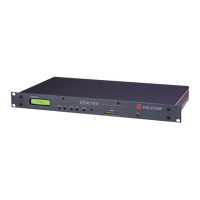TROUBLESHOOTING
© Polycom, Inc. 39 VORTEX EF2211/EF2210 Reference Manual
loudspeakers. The loudspeaker audio is coupled into the room microphones acousti-
cally, through direct and reflected acoustic paths, and perhaps also through mechani-
cal coupling. The microphone signal is then amplified and sent to the AEC as the
local microphone input signal. The room gain of a microphone channel refers to the
relative levels of the signal sent to the loudspeaker output (before any amplification)
and the level of this signal that is reflected as the microphone input (after microphone
amplification).
If the electrical level of the reflected signal picked up by microphone is the same as
the level of the electrical signal sent from the AEC to the loudspeaker output, the
room gain of this microphone channel is said to be 0 dB. If the reflected signal picked
up by the microphone is higher than the level of the signal sent to the loudspeaker out-
put, that microphone channel has positive room gain. The more positive the room
gain, the harder the AEC must work to determine which signal is an echo and which
is a local speech signal.
Excessive Room
Gain
Excessive room gain can be caused through a number of mechanisms:
1. The most common is excessive amplification of the remote (reference) signal at
the local loudspeaker output. This may be explained as follows. If the reference
signal is too low coming into the EF2211/EF2210, i.e. the codec audio signal is
too low, the room audio amplifier is usually used to compensate and bring the
room audio to an acceptable level. For example, if the reference signal is 12 dB
too low, the room audio will need to be amplified by approximately 12 dB to
bring it to a reasonable listening level. This adds 12 dB to the room gain, which
will most likely cause it to exceed the amplifier room gain limit (See “Verify
Room Gain” on page 12). This situation can be remedied by applying enough
gain to the codec, phone or program audio inputs (Inputs A-B) which will make
up the Reference input signal so that the acoustic echo canceller (AEC) sees a
good reference signal rather than trying to compensate at the amplifier.
2. Another common cause of room gain failure is excessive microphone amplifica-
tion. For example, if a microphone is "hot" by 6 dB, then the reflections of the
loudspeaker output signal which are picked up by the microphone will be ampli-
Figure 26. Room Gain.
AEC
A
B
Room Gain = 20 log (B/A)

